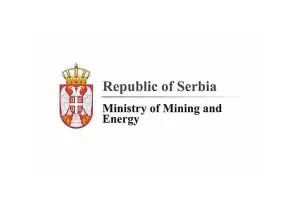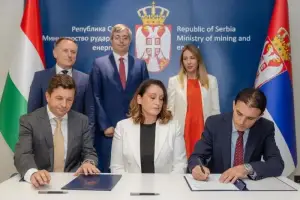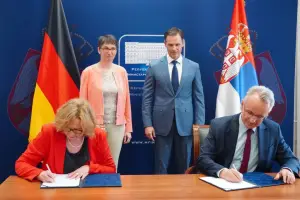- Serbia
Get to know Serbia
- Citizens
Culture and science
Health services
Pension and disability insurance
- Business
Employment
Economy
- Media
- Government
- Contact
Keep in touch
Contact form
Back
Keepin touch
Whether you have a question, comment, suggestion or any problem in the purview of the government, send us your message and we will try to respond as soon as possible. If your problem is not in our purview, we will forward your message to the relevant institution.
Q:
A:
Foreign trade in January–March goes up
Belgrade,
30 April 2008
The Serbian Statistics Office stated today that Serbia's overall foreign trade in the period January-March 2008 totalled $7,938.3 million, up 38.5% against the same period last year, that is, €5,304.7 million or 21.4% against the same period in 2007.
Exports stood at $2,507.9 million, up 37.6% compared to the same period last year, while imports totalled $5,430.4 million, which is a 39% increase in relation to the same period in 2007.
Expressed in euros, exports were worth €1,675.6 million, which is up by 20.5%, while imports were worth €3,629.1 million, up by 21.8% in relation to the same period last year.
Trade deficit was $2,922.5 million, which is an increase of 20.5% on the same period in 2007. Expressed in euros, the deficit stood at €1,953.5 million, up by 22.9% against the same period last year.
The export-import ratio stood at 46.2% and was less than in the same period in 2007, when it stood at 46.6%.
Increased imports in the previous period were a result of the import of energy sources, which account for 21.6% of the total import, and of the import of copper and iron ores, which are used in the production of basic and other metals and have a favourable price on the international market.
Increased exports were driven by the initial effects of privatisation and restructuring of companies, through signed and ratified free trade agreements with signatory countries of the Stability Pact, which are now united under the CEFTA agreement.
Serbia’s exports with CEFTA signatories in the said period stood at $768.3 million and imports at $419.5 million. The surplus is the result of a larger export of agricultural products to these countries.
Increased exports were also due to the surplus in the export of agricultural products, and the export of vegetables and fruit stands at $98 million, whereas the import of citrus fruits remained the same.
The export of wheat and wheat products stood at $79 million.
The trade surplus in the ready-made garments industry (which stood at $67 million) was achieved thanks to the agreement signed with the EU and the preferential status of Serbian goods.
The most exported items in this period were intermediate goods, accounting for 67.1% ($1,683.9 million), followed by consumer goods, which made up 24.4% ($612.3 million) and equipment, accounting for 8.5% ($211.7 million) of total exports.
Imports were dominated by intermediate goods, accounting for 61.9% ($3,361.7 million), followed by consumer goods, 22.8% ($1,236.4 million) and equipment, 15.3% ($832.3 million).
Major importers of goods from Serbia were Italy ($305.9 million), Bosnia-Herzegovina ($282.2 million) and Germany ($273 million). The largest exporters to Serbia were Russia ($950.1 million), Germany ($631 million) and Italy ($501.5 million).
The greatest foreign trade was recorded in commerce with the EU, which accounted for more than half of total trade.
The foreign trade surplus was realised in commerce with Bosnia-Herzegovina, Montenegro and Macedonia. The largest trade deficit was in commerce with Russia and was due to the import of oil and gas.
According to Standard International Trade Classification, iron and steel have the largest share in exports ($329 million), coloured metals ($188 million), garments ($134 million), various products ($115 million) and metal products ($114 million). The export in these five sections makes up 35.1% of overall exports.
The first five sections with the largest share in imports are oil and oil derivatives ($609 million), road vehicles ($448 million), natural gas ($370 million), iron and steel ($240 million) and electrical machines and appliances ($218 million), and their import makes up 34.7% of overall imports.
Expressed in euros, exports were worth €1,675.6 million, which is up by 20.5%, while imports were worth €3,629.1 million, up by 21.8% in relation to the same period last year.
Trade deficit was $2,922.5 million, which is an increase of 20.5% on the same period in 2007. Expressed in euros, the deficit stood at €1,953.5 million, up by 22.9% against the same period last year.
The export-import ratio stood at 46.2% and was less than in the same period in 2007, when it stood at 46.6%.
Increased imports in the previous period were a result of the import of energy sources, which account for 21.6% of the total import, and of the import of copper and iron ores, which are used in the production of basic and other metals and have a favourable price on the international market.
Increased exports were driven by the initial effects of privatisation and restructuring of companies, through signed and ratified free trade agreements with signatory countries of the Stability Pact, which are now united under the CEFTA agreement.
Serbia’s exports with CEFTA signatories in the said period stood at $768.3 million and imports at $419.5 million. The surplus is the result of a larger export of agricultural products to these countries.
Increased exports were also due to the surplus in the export of agricultural products, and the export of vegetables and fruit stands at $98 million, whereas the import of citrus fruits remained the same.
The export of wheat and wheat products stood at $79 million.
The trade surplus in the ready-made garments industry (which stood at $67 million) was achieved thanks to the agreement signed with the EU and the preferential status of Serbian goods.
The most exported items in this period were intermediate goods, accounting for 67.1% ($1,683.9 million), followed by consumer goods, which made up 24.4% ($612.3 million) and equipment, accounting for 8.5% ($211.7 million) of total exports.
Imports were dominated by intermediate goods, accounting for 61.9% ($3,361.7 million), followed by consumer goods, 22.8% ($1,236.4 million) and equipment, 15.3% ($832.3 million).
Major importers of goods from Serbia were Italy ($305.9 million), Bosnia-Herzegovina ($282.2 million) and Germany ($273 million). The largest exporters to Serbia were Russia ($950.1 million), Germany ($631 million) and Italy ($501.5 million).
The greatest foreign trade was recorded in commerce with the EU, which accounted for more than half of total trade.
The foreign trade surplus was realised in commerce with Bosnia-Herzegovina, Montenegro and Macedonia. The largest trade deficit was in commerce with Russia and was due to the import of oil and gas.
According to Standard International Trade Classification, iron and steel have the largest share in exports ($329 million), coloured metals ($188 million), garments ($134 million), various products ($115 million) and metal products ($114 million). The export in these five sections makes up 35.1% of overall exports.
The first five sections with the largest share in imports are oil and oil derivatives ($609 million), road vehicles ($448 million), natural gas ($370 million), iron and steel ($240 million) and electrical machines and appliances ($218 million), and their import makes up 34.7% of overall imports.
-
 Belgrade, 21 July 2025
Belgrade, 21 July 2025Construction of oil pipeline with Hungary to begin early next year
-
 Belgrade/Athens, 17 July 2025
Belgrade/Athens, 17 July 2025Serbia continues to align with EU in field of energy
-
 Kostolac, 14 July 2025
Kostolac, 14 July 2025First solar power plant Petka in Kostolac put into trial operation
-
 Belgrade, 11 July 2025
Belgrade, 11 July 2025Potential for improving cooperation with Belarus in many areas
-
 Požega, 5 July 2025
Požega, 5 July 2025Section of Pakovraće - Požega highway officially opened
-
 Belgrade, 2 July 2025
Belgrade, 2 July 2025Technical specifications defined for Serbia-Hungary oil pipeline
-
 Belgrade, 30 June 2025
Belgrade, 30 June 2025IMF confirms Serbia successfully implementing all agreed reforms
-
 Belgrade, 27 June 2025
Belgrade, 27 June 2025Double Taxation Avoidance Agreement with Germany signed
-
 Kostolac, 25 June 2025
Kostolac, 25 June 2025Construction of Kostolac wind farm nearing completion
-
 Belgrade, 24 June 2025
Belgrade, 24 June 2025Government supports request for new postponement of sanctions against NIS
